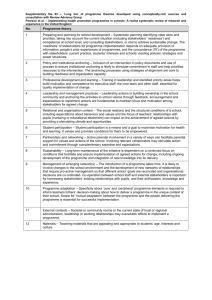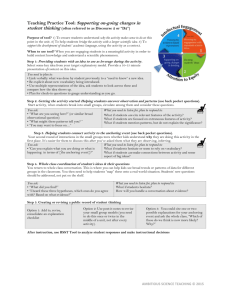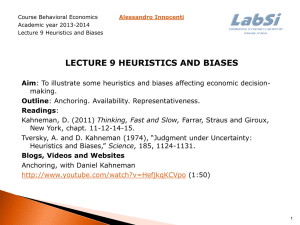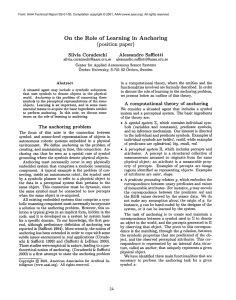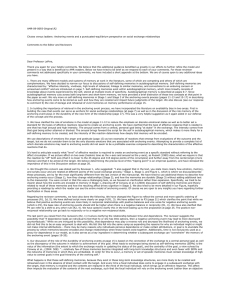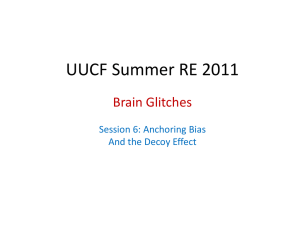Scaffolding PowerPoint
advertisement
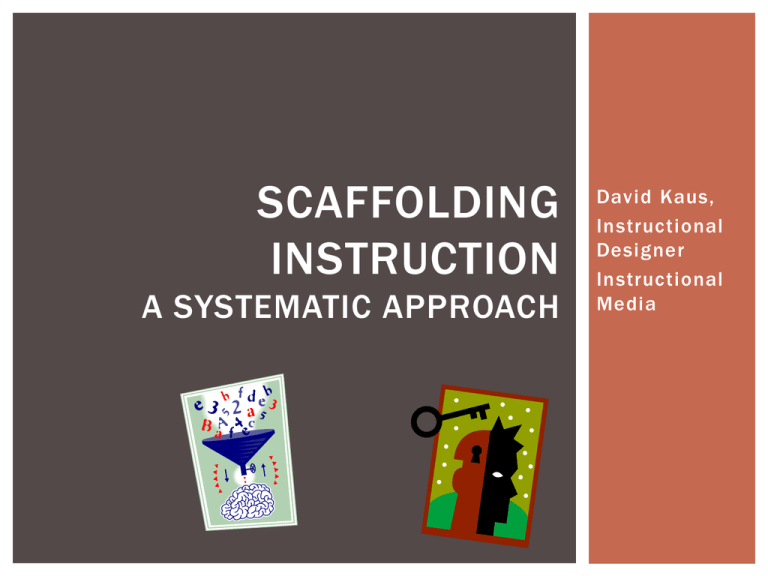
SCAFFOLDING INSTRUCTION A SYSTEMATIC APPROACH David Kaus, Instructional Designer Instructional Media You will need a piece of paper and a pen for this activity. Do not write until instructed to do so. Focus your attention on the middle of the screen. For the following words, count how many syllables are in each word. Onyx Millennium Husband Light-year Bronze Essay Admiral Mule Denim Toaster Ankle Raspberry Write the words now! What What What What What font was mule? font was ankle? font was husband? word was bolded? word was in italics? Was this difficult to recall without knowing what to look for? OBJECTIVES Learn about/reinforce theoretical learning principles Forgetting curve Anchoring ideas Chunking Assessment/reflection *Learn how to apply these principles into instruction THINK BACK… Have you ever been told directions that contain too many details? Have you ever studied for a test and forgotten the content days later? FORGETTING CURVE German psychologist named Herman Ebbinghaus Studied memory and forgetting Created and memorized 2300 “nonsense words” http://helpingpsychology.hubpages.com/hub/Ebbinghaus-ForgettingCurve-The-Theory-of-Memory Retrieved from: http://www.gov.mb.ca/tce/es/archive/oct05/spaced_review.htm FORGETTING CURVE: HOW CAN WE IMPROVE THIS? Repetition – the more you repeat something, the more likely it will be remembered Practical application Review previously covered material with students at the beginning of class Revisit challenging concepts with your students throughout your lecture Create assignments that require students to reexamine earlier material FORGETTING CURVE: HOW CAN WE IMPROVE THIS? Quality of memory representation – create relevant, meaningful connections with new information Learning is more ef fective when it is important to you Practical application When introducing a new concept, explain a situation where it is used, or has been relevant in the real world Allow students to research articles and newspapers that relate to the topic (e.g. NCLB in newspapers) Show a news clip dealing with the topic Administer an interest survey at the beginning of the semester DISCUSSION What materials could you provide to your students that allow them to see the importance of what they are about to learn? KEEPERS (WHAT TO TAKE AWAY FROM THIS) Keepers is a strategy of that focuses on reinforcing the crucial parts of an idea or topic. Repetition assists in memory retention. Frequently revisit earlier, important material with your students. Find examples of how your topic is applicable to real life. ANCHORING IDEAS American psychologist David Ausubel Anchoring ideas are content specific ideas already embedded in one’s cognitive structure (e.g. what a student understands about cell division) Need to link new material with students prior knowledge Learning is much more ef fective when you weave the knowledge you are learning into something you already know Learning is much more difficult when you have to create an entirely new anchoring idea ANCHORING IDEAS Practical application Administer a pre-assessment the first week of class or at the beginning of each lesson (Clickers or Poll Everywhere) Make a list of what everyone knows Create a concept map with students while they are learning the new material Create an outline for students to follow during the lecture Review information from a previous lesson and explain how it relates to the lesson you are about to teach DISCUSSION Think about ways you could introduce a topic to your students that connects to their prior knowledge. KEEPERS Learning is much more ef fective when one can build upon or modify their prior knowledge (anchoring ideas) Before you introduce your topic, find a way to tap into something the students already know and teach from there QUICK REVIEW Repetition - frequently revisit earlier, important material with your students. Quality of memory representation - create relevant, meaningful connections with new information (learning is more ef fective when it is important to you.) Link new material with students’ prior knowledge (anchoring ideas). CHUNKING Breaking down large pieces of information into smaller sections Much easier for the brain to digest the information Divide your content into related sections For online modules, break down larger modules into sections (e.g. Immunizations Part I and Immunizations Part II) For face-to-face courses, take small breaks after about 45 minutes of lecture Retrieved from: http://theelearningcoach.com/elearning_design/chunking-information/ KEEPERS Students will have a dif ficult time retaining information if they are presented with too much material. Chunk your content into manageable sections. ASSESSMENT AND REFLECTION Formative vs. summative assessment Ability to monitor student progress Students actively engaged in acquiring knowledge, instead of passively receiving it Reflection provides students with an opportunity to expand on what they have just learned Allows students to focus on what they already understand, and what they need to study ASSESSMENT AND REFLECTION Practical application Include questions on your topic throughout your presentation/lecture (can use Clickers or Poll Everywhere) Provide students with opportunities to reflect on what they have learned (e.g. learning logs). Ask students questions such as: In what ways do you think you need to improve? What barriers did you encounter during this module? What do you think you need to work on? What part of the lesson are you most comfortable with? How would you explain this to someone who knows nothing about the topic? Include Articulate elements in your presentations DISCUSSION Can you think of some content-specific assessment or reflection questions you can ask your students during lectures? KEEPERS Include assessment questions throughout your lectures Provide students opportunities to reflect on their learning OVERALL REVIEW Repetition - frequently revisit earlier, important material with your students. Create relevant, meaningful connections with new information (learning is more ef fective when it is important to you.) Link new material with students’ prior knowledge (anchoring ideas). “Chunk” your presentations into manageable sections. Include questions throughout your presentations. Provide students with opportunities to reflect on their learning. WORKSHOP TIME! Open your course presentation and try to incorporate some of the learning strategies we just discussed. Feel free to share ideas with others! IN CLOSING What did you like about this workshop? Is there anything you will now try dif ferently in your courses? Is there anything you would like to learn about that we did not cover today? Contact David Kaus dkaus@howardcc.edu or Instructional Media IMfacultylab@howardcc.edu for more information SOURCES/ADDITIONAL RESOURCES http://helpingpsychology.hubpages.com/hub/Ebbinghaus Forgetting-Cur ve-The-Theor y -of-Memor y http://www.gov.mb.ca/tce/es/archive/oct 05/spaced_review.htm http://theelearningcoach.com/elearning_design/chunking information http://www.simplypsychology.org/Zone -of-ProximalDevelopment.html http://helpingpsychology.hubpages.com/hub/Ebbinghaus Forgetting-Cur ve-The-Theor y -of-Memor y http://sidsavara.com/personal -productivity/the -ebbinghaus-cur veof-forgetting http://www.edutopia.org/assessment -guide-importance http://www.cmu.edu/teaching/assessment/basics/formative summative.html
